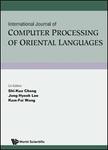版权所有:内蒙古大学图书馆 技术提供:维普资讯• 智图
内蒙古自治区呼和浩特市赛罕区大学西街235号 邮编: 010021

作者机构:Department of Computer Science and Engineering Pohang University of Science and Technology San31 Hyoja-dong Nam-gu Pohang 790–784 Korea Also an assistant professor at Yanbian University of Science and Technology Yanji Jilin China. Also a lecturer at Yanbian University of Science and Technology Yanji Jilin China.
出 版 物:《International Journal of Computer Processing of Languages》
年 卷 期:2003年第16卷第2期
页 面:119-142页
学科分类:08[工学] 0812[工学-计算机科学与技术(可授工学、理学学位)]
主 题:Machine Translation Structural Transfer Ambiguity Transitive Transfer Subject-governing Transfer Verb-governing Transfer
摘 要:We propose a new prototype Chinese-to-Korean machine translation system called TOTAL-CK, a prototype transfer based MT system designed for the large-scale practical domain. TOTAL-CK consists of the components of analysis, transfer, and generation. In this paper, we mainly discuss the transfer issues resulting from stylistic structural differences between Chinese and Korean. The dependency grammar formalism is employed for Chinese parsed trees and their equivalent Korean parsed trees. We deal with structural transfer ambiguities that arise when a given source language syntactic pattern is potentially translated by a number of different target language syntactic patterns. Also, structural transfer ambiguities are the major complex transfer problem appearing during dependency transferring, in an SVO pattern that most frequently occurs in Chinese sentences. There are three types of structural transfer ambiguity: transitive transfer, subject-governing transfer and verb-governing transfer. They are discovered by analyzing the ambiguity and the related formalism. Finally, we present a thesaurus-based disambiguation approach for dependency structural transfer, which is adopted in TOTAL-CK. Our approach achieves 94.6% in precision for SVO sentences and 93.5% for overall sentences.